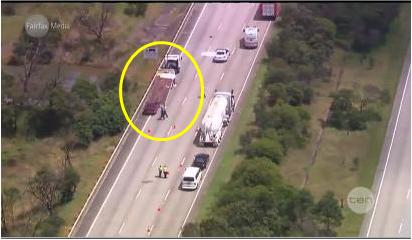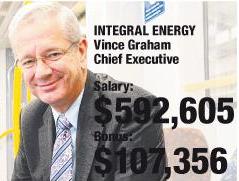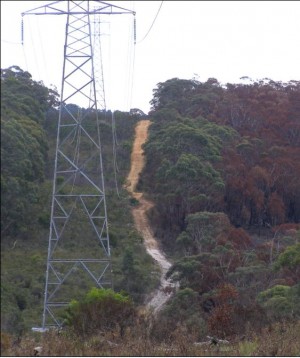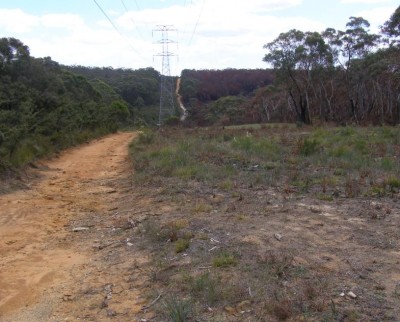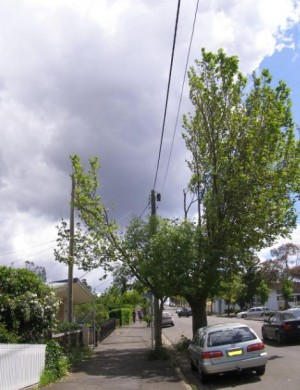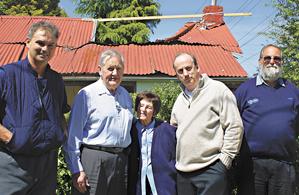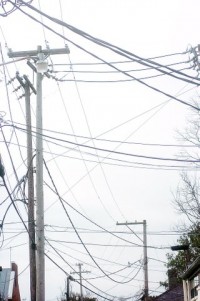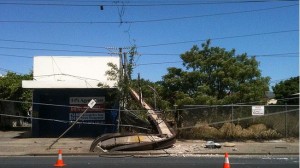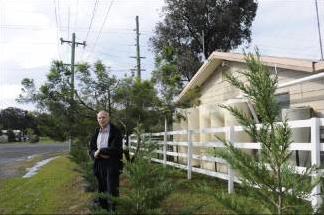RTA narrow shoulder caused tow truck deaths
Thursday, February 16th, 2012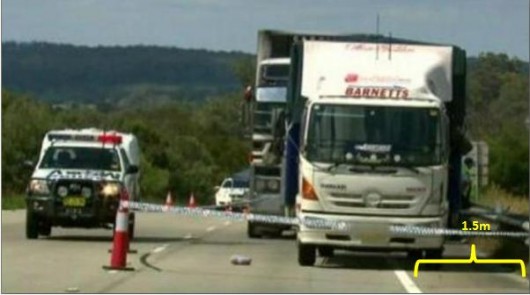 Freeway’s narrow shoulders – obvious death traps
Freeway’s narrow shoulders – obvious death trapsSite of another truck killing – this time the Hume Freeway near the Bowral turnoff, New South Wales
.
Another week, another truck “cleaning up people” on trucking expressways. Expressways with more and faster trucks are more dangerous.
.
Not an unusual breakdown:
.
A young woman travelling south in her car along the Hume Freeway suddenly experiences her car overheating on the Southern Highlands section. The woman rightly pulls over into the left service lane (‘freeway shoulder‘) and she rightly calls the NRMA roadside breakdown service for mechanical assistance.
The NRMA rightly attends the breakdown incident and the mechanic arranges for a vehicle tow. The NRMA subcontracts the tow operation out to local Mittagong-based tow truck operator, Highlander Towing. Owner-operator, Geoffrey Clark, rightly attends with his vehicle tray truck and parks in front of the woman’s car in the service lane. At this section of the Hume, the freeway shoulder is substandard in width and so the towing operation protrudes into the outside freeway lane. The breakdown location is later confirmed by attending police that it was situated on a long straight section of the Hume having a good 500 metre visibility to south approaching traffic.
The tow truck had been tipped in readiness to pull the broken down car on to its tray just before the accident. It is believed Mr Clark and the woman were standing on the roadside of their parked vehicles when a southbound truck struck both Geoffrey and the woman at freeway speed. It is about 12:40pm (midday on a clear day). Both Mr Clarke and the still unidentified young woman died at the scene.
Crash investigators were last night trying to work out how the truck failed to see the woman’s maroon-coloured car and Mr Clark’s truck on the side of the road. It is branded a ‘double fatality’. Traffic is stopped causing congestion. Police and paramedics attend, and the scene is assessed for the coroner.
These two people just going about their normal business suddenly and wrongly have become road ‘statistics’. Statistics for the authorities to collate and report.
.
‘Police said the truck literally cleaned up the two people’
~ The Daily Telegraph (Sydney).
“What chance would anyone have when a truck doing at least 100 kph comes at them?” a police spokesman said.
Yes, roads are dangerous, fast freeways moreso. Cars kill, but trucks kill more easily offering less chance of survival for other road users. When a shoulder on a six laned interstate freeway is designed too narrow to allow safe clearance from high speed traffic, that freeway shoulder is surely a death trap waiting to happen.
Breakdowns beware? If a vehicle breaks down it is involuntary. A driver does not have a choice of continuing on until there is a safe place to pull over, since the vehicle won’t go.
.
The truck killing of two pedestrians is reported to have been horrific. Geoffrey Clark was aged in his 40s and reportedly a father of four. The media have not yet reported the family circumstances of the young woman at the time of publishing today.
 Ave atque vale Geoffrey Clark,
Tow Truck Operator, father-of-four,
and the unidentified standed woman motorist who Geoff dutifully went to assist
(I write that your passings not be in vain)
Ave atque vale Geoffrey Clark,
Tow Truck Operator, father-of-four,
and the unidentified standed woman motorist who Geoff dutifully went to assist
(I write that your passings not be in vain).
According to media reports, Geoffrey Clark, every time a stranded motorist would call him for help, Geoffrey Clark would drop everything and race to their aid. The tow truck company owner and father-of-four was doing exactly that yesterday when he and a female motorist he was helping were run down and killed instantly.
Mr Clark, who operated Highlander Towing, was attending to a broken down Ford sedan in a lane of the Hume Freeway at Mittagong in New South Wales when he was hit by a truck.
The truck driver, from Barnetts courier company (see previous photo of truck ), was taken to hospital with shock.
Distraught employees and friends last night said Mr Clark was a “one in a million” boss who never said no.
“He’d happily go out to help someone in the middle of the night, that’s Geoff,” one employee said. “He was always ready to help, no matter who they were.”
.
Highlander Towing – customer testimonies
‘Prompt and Friendly Service’
(posted by Mun Lum at Tuesday 26 April 2011)
“Our car broke down in Robertson and the company (NRMA recommended) came out fairly promptly and was very helpful in providing advice on where the car can be towed to and repaired. It was over the Easter long weekend and the workshop was not open so they offered to store it at their place until the workshop opened. Great and friendly service. Thoroughly recommended.”
.
‘Highlander Towing’
(posted by Anonymous User at Thursday 30 April 2009)
“Great blokes, Great Service, Highly Recommended”
.
‘Highlander Towing’
(posted by R Maclean at Sunday 18 February 2007)
“I got stranded at Sutton Forest having hit a wombat and my car had to be towed. The guys at Highlander were great – they arrived quickly, stored the car in their warehouse and found me a motel at 1.30 am (all in a black out in Mittagong). The next day they arranged for the car to be trucked to Sydney and I caught a lift with the car. The two guys I encountered were nice blokes (Ray and John) – as a lone female I was a little anxious about who was going to turn up at midnight. I needn’t have worried – Ray who went out of his way to be helpful. Thanks for the help guys, it is much appreciated.”
.
It was the same fatal stretch of the freeway, which last month claimed the lives of three members of the Logan family in another tragic truck accident.
.
RTA meets budget by skimping on safe freeway shoulders
.
RTA’s Budget Shoulder Contingency
.
The pattern of cost blowouts by the RTA’s Major Infrastructure projects must be legion. Its failure to factor in inclement weather contingency and the poor operational management of subcontractors are typical excuses for its record of material cost overruns. But the RTA has long relied upon an internal engineering contingency that enables it to meet the external budget irrespectively.
It works like this – over the lineal distance of a major freeway upgrade project, every metre of widening costs millions. The multiplier effect of highway/freeway/expressway construction is considerable for every inch that is made wider. Freeway shoulders represent the extremes of that widening.
So over an entire project if the freeway shoulder width is trimmed, total project costs can be reduced substantially. So when vague budget cost estimates show signs of blowing out, such freeway shoulders are the contingency that are trimmed in width and thus cost. And who’s going to notice outside RTA internal design engineering?
Voila! Project on budget and management bonuses paid thank you very much. But tell that to the families of the two innocent people mentioned above who were yesterday using the RTA’s ‘high standard’ interstate six-laned dual carriage Hume Freeway.
.
Narrow freeway shoulders are designed death traps
.
But the narrowing of freeway shoulders may save money but compromises safety. Given that standard truck width is 2.5 metres, all freeway shoulders that are gazetted as designated truck routes for safety reasons need to be designed with at width to safety accommodate a truck of 2.5 metres in width.
The Hume Freeway is one of Australia’s major inter-city highways, running for 880 km between Sydney and Melbourne. It is part of the Auslink National Network and is a vital link for road freight to transport goods to and from the two cities as well as serving Albury-Wodonga and Canberra. At this section through the New Spouth Wales Southern Highlands, the Hume is a six-laned dual carriageway freeway not a highway, which permits a speed limit of 110kpm, it demands a higher standard of safety design. There needs to be an added margin of clearance between a stationary vehicle parked on a freeway shoulder and the traffic including trucks doing 110kph.
Clearly, freeway shoulders on such high speed routes need to have a minimum safety width greater than 2.5 metres.
The RTA (TRMS) is responsible for providing safe freeways to the travelling public and so the RTA the owes all freeway users a general duty of care out of its freeway design including the provision of a safe freeway shoulders. The RTA exercises control over the Hume Freeway, is responsible for its design including adequate freeway shoulders.
In this case of the tragic deaths of the two people on the Hume Freeway yesterday, the RTA has breached that duty of care by providing an unsafe freeway shoulder both from an occupational perspective in the case of the tow truck operator performing a breakdown operation, as well as to freeway users in general. The narrow 1.5 metre freeway shoulder created an obvious and unacceptible danger for any vehicle parked on it that measured over 1.5 metres in width, such as the tow truck (at closer to 2.5 metres in length).
It was the same fatal stretch of the freeway which last month claimed the lives of three members of the Logan family in another tragic truck accident.
 Great Western Expressway
…the Liberal-Labor Government’s Trucking Expressway Vision for the Blue Mountains
(Note the narrow shoulders)
Great Western Expressway
…the Liberal-Labor Government’s Trucking Expressway Vision for the Blue Mountains
(Note the narrow shoulders)
.
The Trucking Expressway Vision – a legacy of Bob Debus MP
.
- Perpetual Four Lanes dividing Blue Mountains communities
- Narrow Shoulder Death Traps
- Unmonitored Continuous 80kph, so nudging 90kph
- Anti-Pedestrian, anti-Schools through towns and villages
- Anti-Wildlife through so-called ‘World Heritage’
- All for bigger, longer, faster trucks and more of them
.
March 2011: Truck hit and run of pedestrian on F3 Freeway
.
A year ago police were called to investigate the discovery of human remains thought to be those of a male on the F3 Freeway near Somersby on the NSW central coast.
On 1st March 2011, human body parts were found strewn across two lanes in what police suspected of a truck hit and run accident. Police were reported searching the area near the Gosford off-ramp north of Sydney, after a motorist reported the gruesome find about 11.45pm near midnight.
.
Revelations: 1990 ‘NSW Heavy Vehicle Crash Study’ by Monash University
.In 1990, the Australian Federal Office of Road Safety (Canberra) together with the New South Wales Safety Bureau commissioned a study to examine the cause of crashes involving heavy vehicles in New South Wales between 1988-89 and to suggest countermeasures.
In summary, the findings of the study by the Monash University Accident Research Centre in 1990 found that factors that contributed to producing a severe truck crash environment in NSW included undivided highways of poor standard (including narrow shoulders). The study’s recommended counter-measures from the study included road improvements (at blackspots, delineation, road shoulders, culvert protection).
Read ‘NSW Heavy Vehicle Crash Study Final Technical Report‘. (File size: 14MB)
.
NSW Government culpability questions to answer:
.
- What recommendations of the 1990 Monash Report did the RTA implement and where, and not implement and where?
- Why does Australia’s possibly busiest national truck route, the Hume, have substandard freeway shoulder widths to allow for a standard truck, let alone allow for a width of necessary safety margin to separate high speed traffic and breakdown vehicles parked in the shoulder?
- What is the RTA’s standard procedure for addressing vehicle breakdowns on the Hume, notably along the Southern Highlands section of the Hume?
- If standard procedure was followed in this case by both the NRMA and the towing company, how is the NSW RTA (NSW Transport Road and Marine Services) not liable for breaching its public duty of care and contributing to the tragic deaths of these two freeway users going about their ordinary business?
.
Footnote
.
‘Families praise pair killed in highway tragedy’
[Source: ‘Families praise pair killed in highway tragedy’, by Lisa Davies, Sydney Morning Herald, 20120217, p.6.^http://www.smh.com.au/nsw/families-praise-pair-killed-in-highway-tragedy-20120216-1tbtf.html]
.‘A tow truck driver and a woman whose car had broken down on the side of the Hume Highway near Mittagong were killed by a passing truck, Wednesday.
Sarah Frazer was finally about to fulfil her dream, which was to study in pursuit of her great passion – photography.
”My car is pretty much all packed up except for my bedlinen and a few loose ends,” the 23-year-old wrote to her aunt on a Facebook page.
But less than 24 hours later, not long after she started out on her ”newest adventure”, she was killed on her way to university in Wagga Wagga. Her faithful car, brimming with her possessions, had failed her when she needed it most, breaking down along the way. Ms Frazer and the man who came to her aid on the Hume Highway were both killed instantly on Wednesday when a truck failed to see them until it was too late. A tow-truck driver and well regarded southern highlands local, Geoff Clark, had rushed to Ms Frazer’s aid when her car broke down on a narrow stretch of the highway, about two kilometres from Mittagong.
Her car could fit only partly in the road’s shoulder, and the two were trying to prepare it for towing. It is believed the truck driver may simply have seen the two vehicles too late.
Ms Frazer, from Springwood in the Blue Mountains and a former student at St Columba’s High School, was described yesterday as ”a truly amazing person”.
”A world traveller, fearless, funny, kind, strong willed, bright and beautiful,” her aunt Kristina wrote on Facebook.
”She was my niece and my friend. I will miss her terribly.”
Another relative described his family’s grief on such a ”very sad day”, saying his ”beautiful, intelligent cousin” had died ”on her way to start a new life” at university.
Police are investigating the crash and the truck driver is assisting with inquiries. The driver was treated for shock at Bowral Hospital.
Mr Clark, a father of four young boys aged 8 to 14, was hailed as a good Samaritan for stopping on the dangerous strip of the highway and volunteering to drive Ms Frazer to Wagga Wagga.
Inspector Mark Wall, from Bowral police, who knew Mr Clark, said he was ”a hard worker and a good bloke”. He had been a truck driver for most of his life before starting his own towing business eight years ago. His widow, Sam, told reporters: ”He was a very caring husband. Thoughtful, just the best really … he did all that he could do to be safe.”
 Sarah Frazer
Ed: Too young. It is not right. Our highways and freeways need to be safer.
Sarah Frazer
Ed: Too young. It is not right. Our highways and freeways need to be safer.
.
References
.
[1] ‘Two killed as truck hits breakdown operation on highway‘, by Alicia Wood, 20120215, ^http://www.smh.com.au/nsw/two-killed-as-truck-hits-breakdown-operation-on-highway-20120215-1t5lm.html.
[2] ‘Two killed in Hume Highway tragedy near Mittagong‘, by Clementine Cuneo, Police Reporter, The Daily Telegraph, 20120215, ^http://www.dailytelegraph.com.au/news/sydney-nsw/two-killed-in-hume-hwy-smash/story-fnb5f12x-1226271751142.
[3] ‘Two killed in crash near Mittagong‘, SkyNews, 20120215, ^http://www.skynews.com.au/national/article.aspx?id=718772&vId=.
[4] ‘Man dies on road as he came to woman’s rescue‘, The Daily Telegraph, 20120216, ^http://www.news.com.au/national/man-dies-on-road-as-he-came-to-womans-rescue/story-e6frfkvr-1226272184058.
[5] Highlander Towing Pty Limited, ^http://www.thesouthernhighlands.com.au/directory/travel/couriers/highlander-towing.
[6] ‘Human remains scattered on F3: police suspect hit and run‘, by Stephanie Gardiner, 20110302, ^http://www.smh.com.au/nsw/human-remains-scattered-on-f3-police-suspect-hit-and-run-20110302-1bdjb.html.
[7] ‘Heavy Vehicle Crash Study Final Technical Report‘, Monash, ^http://www.monash.edu.au/miri/research/reports/atsb092.pdf